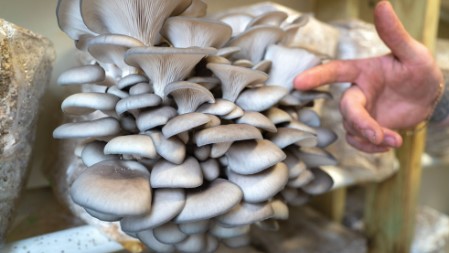How do you grow blue oyster mushrooms at home?
How do you grow blue oyster mushrooms at home?

1. Introduction
Growing mushrooms at home has become increasingly popular among gardening enthusiasts and food lovers alike. Blue oyster mushrooms, in particular, offer a unique flavor and aesthetic appeal that make them a sought-after choice for home cultivation. In this guide, we will explore the step-by-step process of growing blue oyster mushrooms indoors, from understanding their requirements to harvesting the fruits of your labor.
2. Understanding Blue Oyster Mushrooms
Blue oyster mushrooms (Pleurotus ostreatus) are a species of edible fungi known for their vibrant blue hue and delicate flavor profile. They are relatively easy to cultivate and thrive in a variety of conditions, making them ideal for home cultivation. Blue oyster mushroom are rich in nutrients, including protein, fiber, and various vitamins and minerals, making them a healthy addition to any diet.
3. Growing Blue Oyster Mushrooms Indoors
Materials Needed:
- Blue oyster mushroom spawn
- Substrate (such as straw, sawdust, or coffee grounds)
- Large plastic bags or containers
- Water spray bottle
- Drill or sharp object for making holes
- Humidifier (optional)
- Sterilized environment (optional)
Steps to Growing Blue Oyster Mushrooms:
- Prepare the Substrate: Depending on your chosen substrate, prepare it by pasteurizing or sterilizing it to eliminate any competing microorganisms that could inhibit mushroom growth. Allow the substrate to cool before proceeding.
- Inoculate the Substrate: Once the substrate has cooled, mix it thoroughly with the blue oyster mushroom spawn. Ensure an even distribution of spawn throughout the substrate to promote uniform colonization.
- Packaging: Transfer the inoculated substrate into large plastic bags or containers. Leave enough space for the mushrooms to grow and for air circulation. Seal the bags or containers, leaving some small holes for gas exchange.
- Incubation: Place the sealed bags or containers in a warm, dark place with temperatures ranging between 70-75°F (21-24°C). Keep the substrate moist by spraying it with water regularly.
- Colonization: Over the next few weeks, monitor the bags or containers for signs of colonization. You should start to see white mycelium spreading throughout the substrate.
- Fruiting: Once the substrate is fully colonized, expose it to indirect light and lower the temperature slightly (around 60-65°F or 15-18°C). Mist the surface of the substrate regularly to maintain humidity levels.
- Harvesting: After a few weeks, small pins will begin to form, which will develop into mature mushrooms. Harvest the mushrooms when they are still young and firm by gently twisting them from the substrate.
4. Caring for Blue Oyster Mushrooms
Maintaining Proper Conditions:
- Temperature: Blue oyster mushrooms thrive in temperatures between 60-75°F (15-24°C). Avoid extreme temperature fluctuations, as they can stress the mushrooms and inhibit growth.
- Humidity: Maintain high humidity levels (around 85-90%) to encourage mushroom growth. Use a humidifier or mist the substrate regularly to keep humidity levels consistent.
- Light: While blue oyster mushrooms do not require direct sunlight, they do need some indirect light to stimulate fruiting. Place them in a well-lit area away from direct sunlight.
Harvesting Blue Oyster Mushrooms:
- Harvest the mushrooms when they are young and firm, just before the caps begin to flatten out. This ensures optimal flavor and texture.
- Use clean hands or a knife to gently twist or cut the mushrooms from the substrate. Avoid damaging the surrounding mycelium to encourage future flushes.
5. Common Problems and Solutions
Problem: Contamination
- Solution: Ensure proper sterilization or pasteurization of the substrate and maintain a clean environment to minimize the risk of contamination.
Problem: Poor Fruiting
- Solution: Check and adjust temperature, humidity, and light levels as needed. Ensure proper air circulation and mist the substrate regularly to maintain optimal conditions for fruiting.
Problem: Slow Colonization
- Solution: Ensure the substrate is properly hydrated and mix the spawn thoroughly to promote even colonization. Keep the substrate in a warm, dark environment and monitor for signs of growth.
At Lone Star Mushrooms, our mission is simple yet profound—to provide a diverse range of high-quality mushrooms while prioritizing environmental responsibility. We believe in the magic of mushrooms not only as a culinary delight but also as a sustainable and nutritious food source.
6. Conclusion
Growing blue oyster mushrooms at home can be a rewarding and enjoyable experience. By understanding their requirements and following the steps outlined in this guide, you can successfully cultivate these flavorful fungi in your own kitchen or backyard. Whether you’re a seasoned mushroom cultivator or a beginner looking to try your hand at home gardening, blue oyster mushrooms are a fantastic choice for anyone interested in sustainable and delicious food production. So roll up your sleeves, gather your materials, and get ready to enjoy the fruits of your labor!




